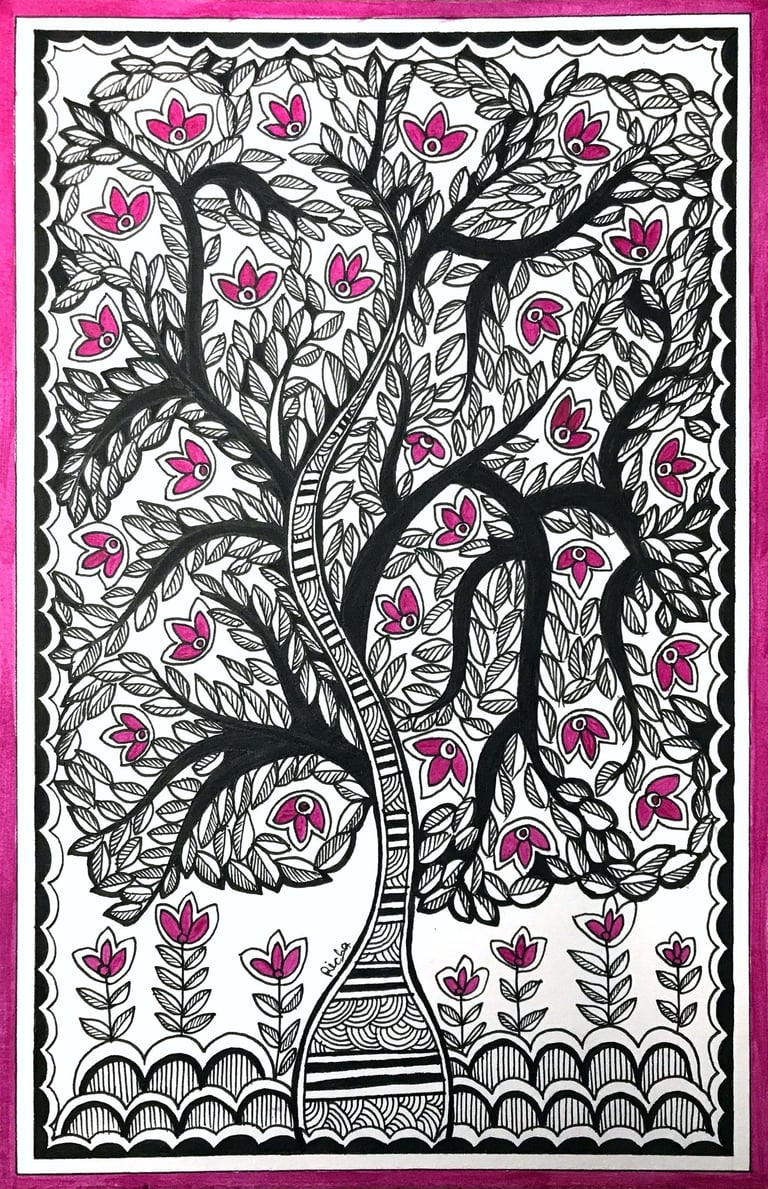Exploring the Symbolism and Beauty of Madhubani Painting: The Tree of Life
Madhubani painting, with its intricate patterns, vibrant colors, and rich cultural heritage, has captivated art enthusiasts around the world. Among the many motifs that adorn Madhubani artwork, the Tree of Life stands out as a symbol of vitality, spirituality, and interconnectedness. In this blog, we delve into the significance and beauty of the Madhubani Tree of Life motif.
The Origins of Madhubani Art:
Madhubani art finds its roots in the Mithila region of Bihar, India, where it has been practiced for centuries. Traditionally, Madhubani paintings were created by women on the walls of their homes to mark auspicious occasions such as weddings, festivals, and births. Over time, the art form evolved to include canvas paintings, depicting a wide range of subjects inspired by nature, mythology, and everyday life.
The Tree of Life Motif:
Central to Madhubani art is the Tree of Life motif, which symbolizes the interconnectedness of all living beings and the cyclical nature of existence. The tree, often depicted in a symmetrical and stylized form, is adorned with intricate patterns, colorful foliage, and symbolic elements such as birds, animals, and human figures.
Symbolism of the Tree of Life:
The Tree of Life holds profound symbolism in various cultures and spiritual traditions. In Madhubani art, it represents:
Vitality and Growth: The tree's lush foliage and sprawling branches symbolize vitality, growth, and abundance.
Spirituality: The roots of the tree, deeply embedded in the earth, symbolize a connection to the divine and spiritual realms.
Harmony and Interconnectedness: The interconnected branches and roots signify the unity and interconnectedness of all living beings and the natural world.
Renewal and Regeneration: Like the cycles of nature, the Tree of Life represents renewal, regeneration, and the eternal cycle of birth, death, and rebirth.
The Beauty of Madhubani Tree of Life Paintings:
Madhubani artists infuse the Tree of Life motif with vibrant colors, intricate patterns, and meticulous details, creating visually stunning artworks that evoke a sense of wonder and awe. Each painting is a masterpiece of craftsmanship, reflecting the artist's skill, creativity, and cultural heritage.
Appreciating Madhubani Art:
As admirers of art, we can appreciate the beauty and symbolism of Madhubani Tree of Life paintings for their aesthetic appeal and spiritual significance. By exploring the intricate details and symbolism embedded within each artwork, we gain a deeper understanding of Madhubani art's cultural significance and timeless beauty.
In conclusion, Madhubani Tree of Life paintings serve as powerful symbols of vitality, spirituality, and interconnectedness. Through their exquisite craftsmanship and profound symbolism, these artworks transcend time and space, inviting us to contemplate the mysteries of life and celebrate the beauty of nature.
Whether displayed in homes, galleries, or museums, Madhubani Tree of Life paintings continue to inspire and enchant viewers around the world, reminding us of the timeless wisdom and enduring beauty of this ancient art form.
Let us celebrate the rich heritage and artistic legacy of Madhubani painting, embracing its beauty, symbolism, and spiritual essence.



